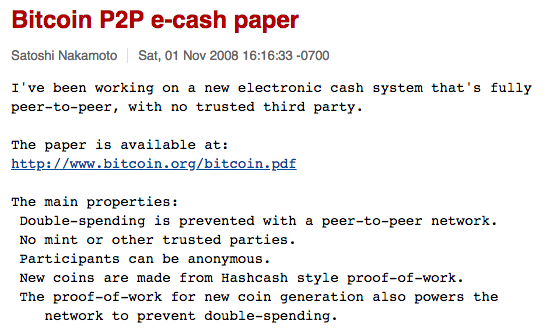Four years ago on this day, the 29th of August 2019, the first commit was made which would later evolve into the BlenderBIM Add-on.
I'd like to reflect on some of the milestones and statistics we've started to collect, and speculate on where we're headed. But before we begin, I'd like to emphasize the goal of the BlenderBIM Add-on project:
The objective of the BlenderBIM Add-on project is to provide a complete free OpenBIM software workflow using for our built environment. Everybody should have the ability to work from early feasibility and concept phase, project coordination, detailed design, fabrication & construction, facility management and building maintenance, post-occupancy evaluation, and tear-down.
In addition to providing features equivalent to existing proprietary software, the new tools will be different in two ways. First, they will be highly modular, allowing users to mix and match to create their own pipelines tailored to their needs, and easily modify or extend the pipeline if it does not suit their needs. The user should have full control over their tools. Secondly, the tools will uphold the highest standards possible of open data standards, exchange, and interoperability conventions, allowing us to integrate data across disciplines to make wiser decisions in the design and management of the built environment.
The BlenderBIM Add-on started when a small commercial building project was designed in Blender. We were then faced with the task of remodeling it in Autodesk Revit. We figured it would be easier to build an entire BIM application and construction documentation tool from scratch rather than face the pain of remodeling it in Revit. It turned out that it was :)
The first 83 lines of code were committed that exported a single site, building, story, and converted objects into faceted brep proxies. The Suzanne monkey was the very first IFC export.
These naive 83 lines of code have grown from being used to visualise compactor machine data when building highways, train station facility management in Australia, to the Hinkley Point C nuclear power plant in the UK. From being used in acupuncturial points within project workflows, we've now taken baby steps into end-to-end project delivery for small scale projects. There have also be numerous presentations at industry events, talks, magazines, podcasts, etc, such as FOSDEM, BILT, CAAD Futures, AEC Magazine, PyCon, and the Boao ISTIF Forum. There have also been multiple academic presentations and academic papers published.
You can read are more detailed history of milestones in the OSArch Wiki.
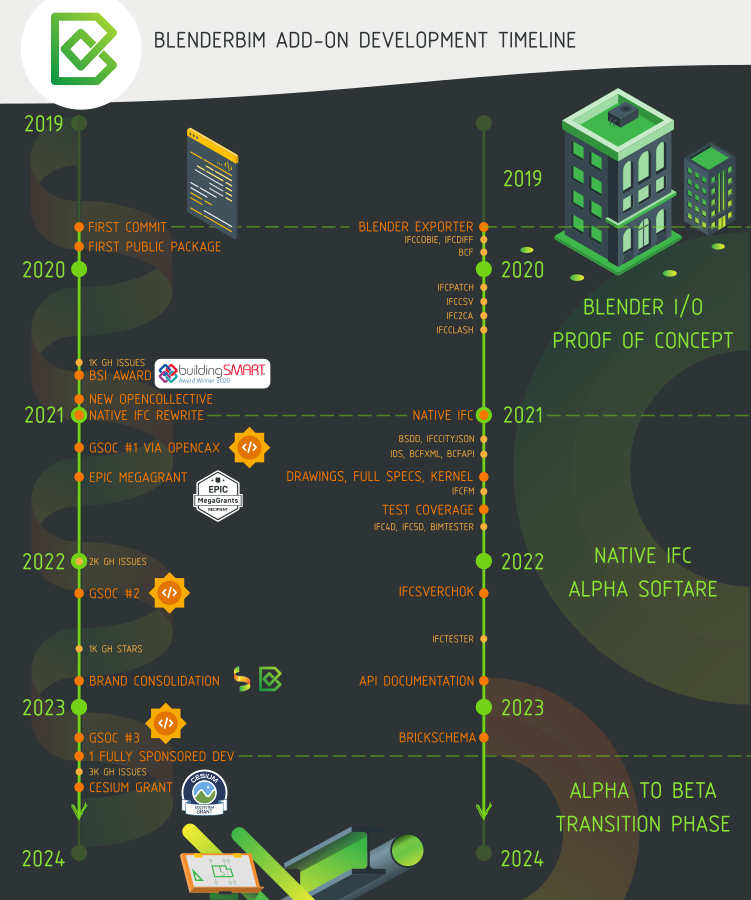
I believe since early 2023, we are entering a phase where we transition from an alpha to beta, where people can begin to deliver end-to-end small projects with only free software. The major milestone that starts this transition is Andrej joining the team as the first fully sponsored developer. Beta is not just about features and stability, it's also about documentation, training, brand, and financial stability. Thanks to your community contributions, this is the first time we have had enough funding to fully sponsor a developer. This ensures that we can keep up the pace that the community needs.
We've started haphazardly measuring statistics since the beginning of this year, so let's see what that means. Note that statistics for 2023 are naturally incomplete.
IfcOpenShell began in 2011 mostly as a lone wolf effort by Thomas Krijnen. Since then, commits have jumped significantly. I'd say Python is a bit more of a commit heavy language, but also helps lower the bar to new contributors.
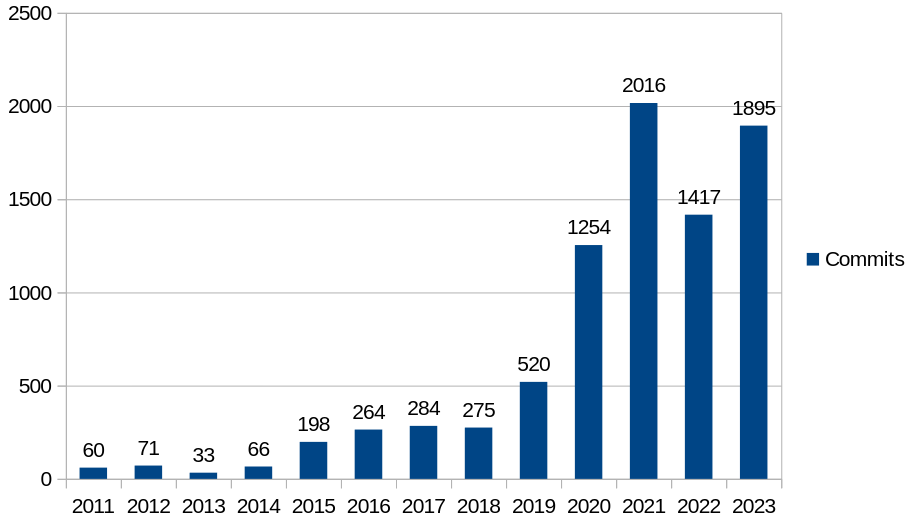
We are now at 53 annual contributors. Of which 18 have made more than 10 annual commits.

Reflecting the number of contributors is the number of issues reported. We're closing in on 1,000 new issues every year, which is a lot to keep on top of for a growing project.
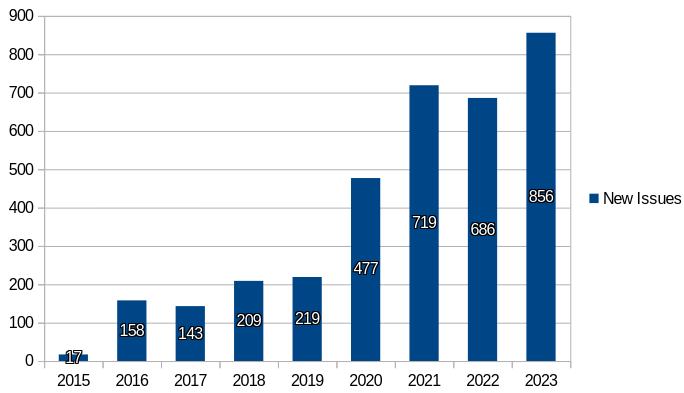
Despite this issue growth, we've managed to address the vast majority of them, with an 85% chance that your issue will be resolved sooner or later.

This graph of active (unclosed) issues over time show the turbulent ridges and valleys as we attempt to address issues whilst still building features not on the issues list.

Popularity wise, Github stars have seen a gradual and slowly accelerating increase.

As of this year, we seem to be clocking in roughly about 50,000 downloads per year.
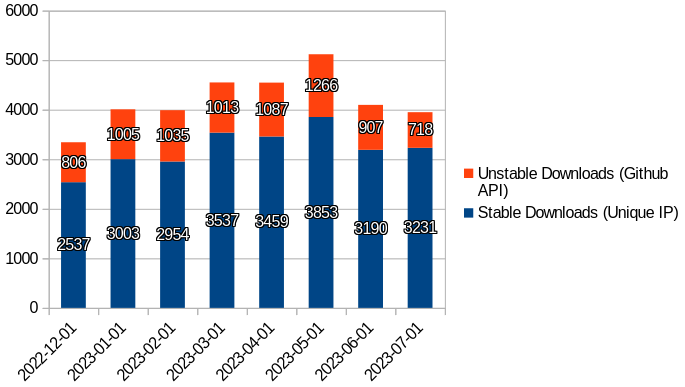
In terms of financials, since the OpenCollective began, we've grown from humbly accepting generous donations and merely covering hardware costs to now at the incredible and scary stage where our expenses exceed our income where we are investing heavily into as much development as possible. Note that these exclude any specific grant funding (e.g. Epic Megagrants, Google Summer of Code stipends, Cesium Ecosystem Grants) or shadow funding and only represent our OpenCollective funding.

All this would not be possible without Thomas Krjinen starting the journey back in 2011, the hundreds of developers (over 150!) that have contributed since then, and hundreds (currently 116) of financial sponsors who have helped it grow, and hopefully will continue to help it grow sustainably to tackle the mammoth ambitions of the project.

Here's to another successful year!
P.S. as a little bonus whilst I was doing these statistics I did a bit of research on other projects. Here are some ballpark figures I gathered from various sources and other project contributors. Emphasis on "ballpark" - as you know this stuff is really hard to measure and there's a lot of "shadow funding" and "double counting" or "bot / automated activity" etc which is difficult to address so empty out your salt shakers please. Just for fun :)

